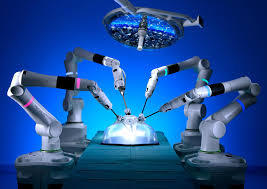#Medical Robotic System Techonology
Explore tagged Tumblr posts
Text
Medical Robotic Systems of the Future

Introduction Robotic systems have drastically changed the field of medicine and healthcare over the past few decades. By augmenting a surgeon's abilities, these systems allow for minimally invasive procedures that reduce recovery time for patients. Looking ahead, newer generations of robots promise even greater precision and autonomy. Advancing Surgical Medical Robotic Systems Surgical robots like da Vinci allow a surgeon to operate through small incisions from a console several feet away. da Vinci's wrists and instruments provide 7 degrees of freedom similar to the human hand, enhancing control and visibility. New models add features like a separate robot arm for assisting the main surgeon. As robotic arms and components evolve to maximize agility and precision, procedures that were previously difficult or risky can be improved. Enhanced Mobility for Rehabilitation For patients recovering from injuries or surgeries, robotic exoskeletons and prosthetics are restoring mobility. Exoskeletons allow paraplegics to stand and move about with motors augmenting weakened legs and hips. Prosthetic hands and arms powered by miniature motors can perform delicate tasks like play piano. Continued advances may one day provide near-natural alternatives to lost limbs through highly dexterous robotic replacements. Medical Robotic System Assistance for Healthcare Workers In hospitals, robots are taking up duties to help overburdened nurses and doctors. Automated carts deliver meals, supplies and medication between floors, reducing time spent searching for items. Mobile robots guide visitors to patient rooms and provide information displays. For infectious patients, robot assistants allow remote video visits while safely limiting exposure. This growing robotic support helps maximize valuable human time and resources. Precision Robots in Non-Invasive Diagnostics Certain medical diagnostic robots can examine the body in delicate, non-invasive ways. Capsule endoscopes are swallowable cameras that capture high definition videos of the entire digestive tract. Retinal scanning robots take ultra high resolution photos of the eye to screen for conditions like diabetes or glaucoma. Miniature swimming robots explore blood vessels to locate blockages, acting as nanosubmarines inside the body. As diagnostic technology improves, robotic tools may uncover medical problems at even earlier stages. The Future of Assistive Care Medical Robotic System In future decades, robotics will likely become further integrated into healthcare through assistive robots focused on well-being. Companion robots can check vitals, remind patients to take medications, and reduce feelings of loneliness or isolation for the elderly living independently. Nursing robots may lift or turn bedridden patients with human-level gentleness. Miniature nanobots one day may precisely deliver drugs, patch tissues at a cellular level or flush toxins from the liver. Combined with continued advances in artificial intelligence, medical robots will reshape healthcare as they take increasingly supportive caregiving roles.
About Author:
Ravina Pandya, Content Writer, has a strong foothold in the market research industry. She specializes in writing well-researched articles from different industries, including food and beverages, information and technology, healthcare, chemical and materials, etc. (https://www.linkedin.com/in/ravina-pandya-1a3984191
0 notes
Text
LiDAR Services Market Size Worth $2.6 Billion By 2025 | CAGR: 14.5% | Global and Regional Forecast | Grand View Research, Inc.

The global LiDAR services market size is expected to reach USD 2.6 billion by 2025, registering a CAGR of 14.5% from 2019 to 2025, according to a new study by Grand View Research, Inc. LiDAR services find prominent applications in the automotive industry. Further, favorable government policies regarding self-driven vehicles and advanced driver-assistance systems (ADAS) are fueling market growth.
The use of LiDAR services in autonomous vehicles is one of the major factors driving the market. Furthermore, increasing automobile production across developed and developing economies, along with the growing demand for technologically advanced electronic safety systems in vehicles, are the major factors positively impacting market growth. The implementation of stringent carbon emission norms are driving demand for next-generation technologies, such as advanced driving systems. This, in turn, is likely to drive demand for LiDAR services over the forecast period. Further, LiDAR sensors are also used for security, surveillance, and logistics in industrial automation. The extensive use of sensors in the automotive and industrial automation industry is anticipated to positively influence the market over the forecast period.
The market is anticipated to be driven by growing 3D imaging technology. The growing use of 3D imaging enabled devices, such as the robotic vision system, medical imaging device, and the 3D X-ray imaging device, are expected to boost the growth of the market. Besides, the implementation of LiDAR services in 3D imaging is expected to boost its demand in the healthcare industry.
North America held largest market share in 2018, followed by Asia Pacific and Europe. The Asia Pacific regional market is expected to witness robust growth over the forecast period, owing to the increasing awareness regarding the benefits of the techonology in the automotive and industrial automation industry. Moreover, the rise in demand can be attributed to the growth in adoption of ADAS in autonomous cars in China, Japan, South Korea, and Singapore.
Browse Full Report (Tables & Figures) @ https://www.grandviewresearch.com/industry-analysis/lidar-services-market
Contact Us:
Grand View Research, Inc. 201 Spear Street 1100, San Francisco, CA 94105 United States
Phone: 1-415-349-0058 Toll Free: 1-888-202-9519 Email: [email protected]
0 notes